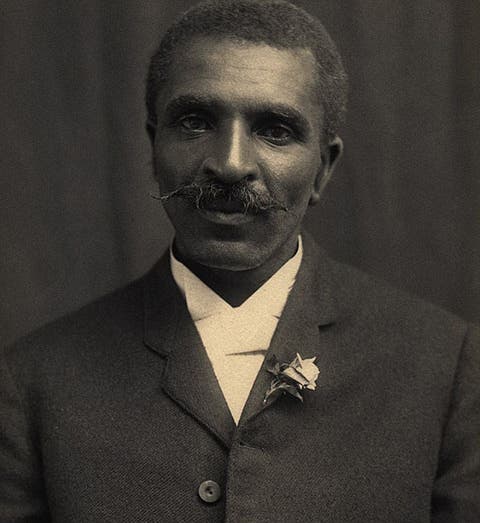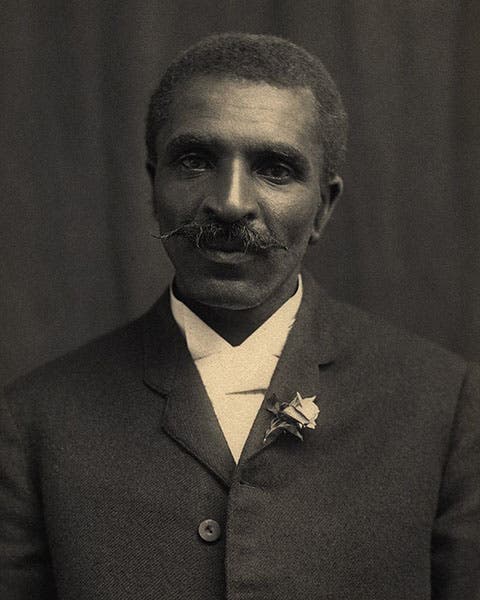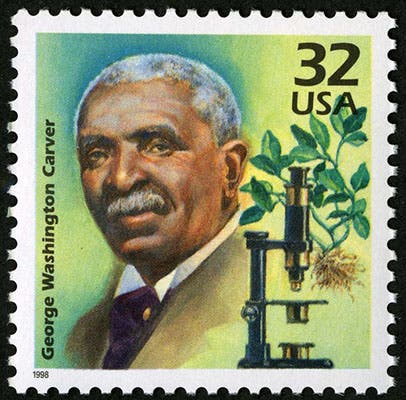Scientist of the Day - George Washington Carver
George Washington Carver, an American agricultural botanist, died Jan. 5, 1943, at the age of 78 or 79. He had been born into slavery around 1864, the slave-owner being Moses Carver, who owned a farm in southwestern Missouri. Infant George and his mother were kidnapped by slave traders and George was ransomed, although his mother was never located. Carver granted young George his freedom and saw to his education; George himself was partial to the study of plants from his years on the farm. George later took (or was given) Carver's name as a surname. He then adopted "W" for a middle initial. The suggestion that it might stand for "Washington" came from a reporter. George himself never used the name Washington, signing his articles and letters as "George W. Carver."
Carver attended schools in various places, in Kansas and in Iowa, before finally settling in at the Iowa Agricultural College at Ames (now Iowa State), majoring in agricultural botany. He received his B.S. in 1894 and immediately joined the faculty in Ames, the first black American to do so. Two years later, Booker T. Washington tapped Carver to establish an agricultural department at the Tuskegee Institute in Alabama, which Washington had just founded. Carver taught there his entire career, although he much preferred working in the experimental station to being in the classroom. He founded and edited the Bulletin of the Tuskegee Institute Experimental Station and wrote and published its first 44 issues.
There is a vast legend that has been built up around Carver, most of which is not true. It is hard and perhaps unwise to take on that legend, as it just makes people mad to have their heroes demythologized, so perhaps we can just explain what Carver did, and what he did not do. Carver deserves great admiration for overcoming the circumstances of his humble origins, for educating himself at a time when that was difficult for a young black man to do, and for distinguishing himself in college, so that Booker T. Washington came calling. At Tuskegee Institute, and in his annual Bulletins, he argued that Alabaman black farmers needed to wean themselves from cotton, which ruined the soil, and he advocated the planting of alternate crops, such as sweet potatoes, cowpeas, soy, and peanuts, which would not only provide an additional source of income, but would restore fertility to the soil. He was an early advocate for environmentalism and the protection of resources, at a time when that was an uncommon approach to farming. He attracted the attention of eminent men, such as Henry Ford, who thought Carver an exceptional scientist, and various Secretaries of Agriculture, who brought him to Washington to testify before Congressional committees. In the 1930s, Carver was probably the best-known black scientist in America. It didn’t hurt that Henry Wallace, the Secretary of Agriculture under Roosevelt, studied under Carver in Iowa.
The rest of the Carver legend does not hold up so well. Carver did not invent 300 ways of using peanuts, or 100 uses for sweet potatoes. He invented hardly anything at all, acquiring only three patents in his entire life. He produced no formulas for anything; indeed, he did not even keep a laboratory notebook. He did write articles extoling the virtues of peanuts and sweet potatoes and their many uses, but he does not seem to have discovered those uses himself; he mostly passed along ideas from Department of Agriculture bulletins. Southerners were growing peanuts long before Carver suggested they do so; indeed, peanut production in Alabama peaked before Carver wrote his famous Bulletin 31 in 1916, giving 105 uses for peanuts, and tailed off thereafter. There is no evidence that Carver played a role in breaking the cotton monopoly, or that he saved the Southern economy by his suggested diversification of crops.
So how did it happen that by the time of his death, Carver was being exalted as the greatest black scientist in history and the inventor of hundreds of new products, and proclaimed the savior of the economy of the South? We can see that this was so from the design for a recruiting poster of 1943, intended to attract black Americans into enlisting in the armed forces (fourth image). In the poster, Carver is called one of America’s great scientists, described as the inventor of over 300 products, many now in use by the armed forces, and on the verge of inventing a substitute for rubber.
The explanation for Carver’s transformation in the eyes of the public is not easy to pin down, although many have tried. Some blame the popular press, which credited Carver with all those inventions (and which Carver never thought to deny). Some point to white politicos in Washington, who saw Carver as an acceptable representative of black America – he had no political agenda, was very religious, and did not press for further black emancipation – and accordingly, built up Carter’s image with achievements that were not his. He became so revered that six months after his death, President Roosevelt established the George Washington Carver National Monument in Newton County, Missouri, on the site of Moses Carver’s farm. There had been two previous National Monuments – one honored George Washington, the other Abraham Lincoln. Carver’s was the third. It covers 240 acres, the original size of the Carver farm, and includes a museum. The site is ten miles southeast of Joplin, not that far from Kansas City. I have never been there, but I now intend to stop in the next time I visit the Crystal Bridges Museum in Arkansas. I am curious as to how the Carver legend is handled by the museum, especially now that I have struggled to deal with it myself.
The legend notwithstanding, Carver, as the best-known 20th-century black American scientist, well deserved a commemorative postage stamp, and he has had two of them, one in 1948, and again in 1998. We show the later stamp here (fifth image). And we have two further comments. Of the 44 Bulletins Carver published at Tuskegee, our library has only two – the last two. I have no idea why we have these and not the rest. But it seems appropriate that the last one, which came out a month after Carver died, was on the subject of: “The Peanut” (third image). And finally, one has to admire the lovely photograph taken of the Tuskegee faculty in 1902 by the incomparable Frances Benjamin Johnston (second image). It is hard to believe that this vibrant photograph is 121 years old. It is a pleasure to be able to include it here.
William B. Ashworth, Jr., Consultant for the History of Science, Linda Hall Library and Associate Professor emeritus, Department of History, University of Missouri-Kansas City. Comments or corrections are welcome; please direct to ashworthw@umkc.edu.











